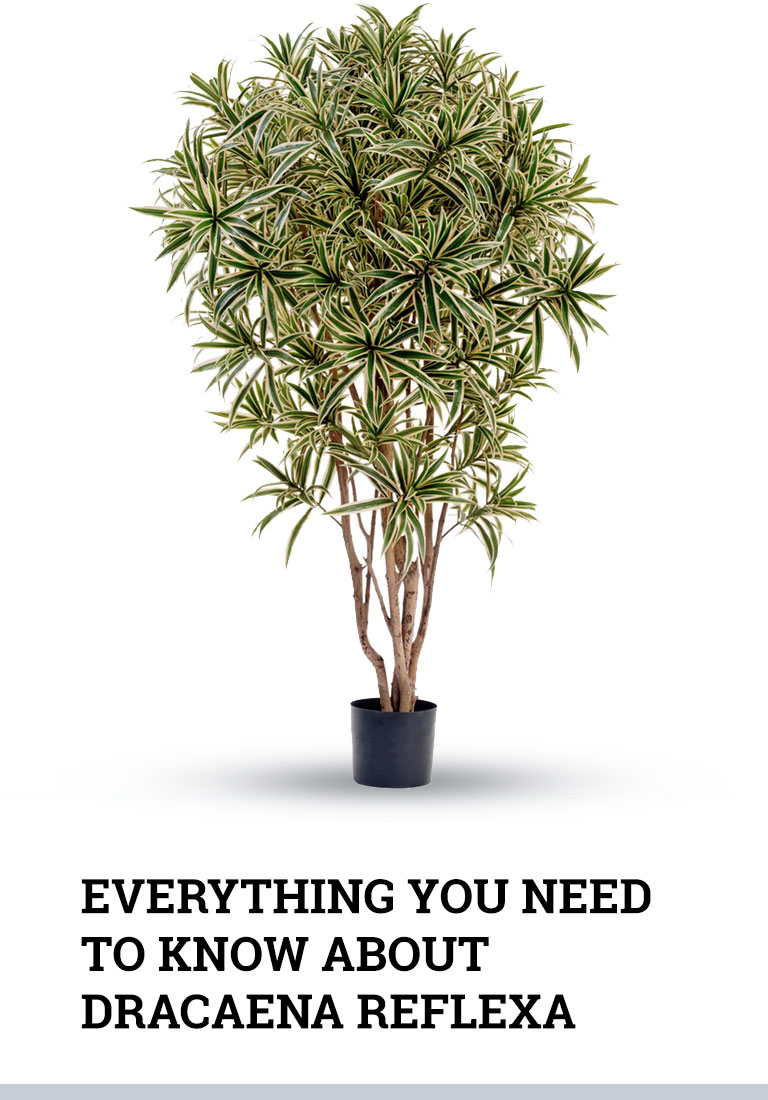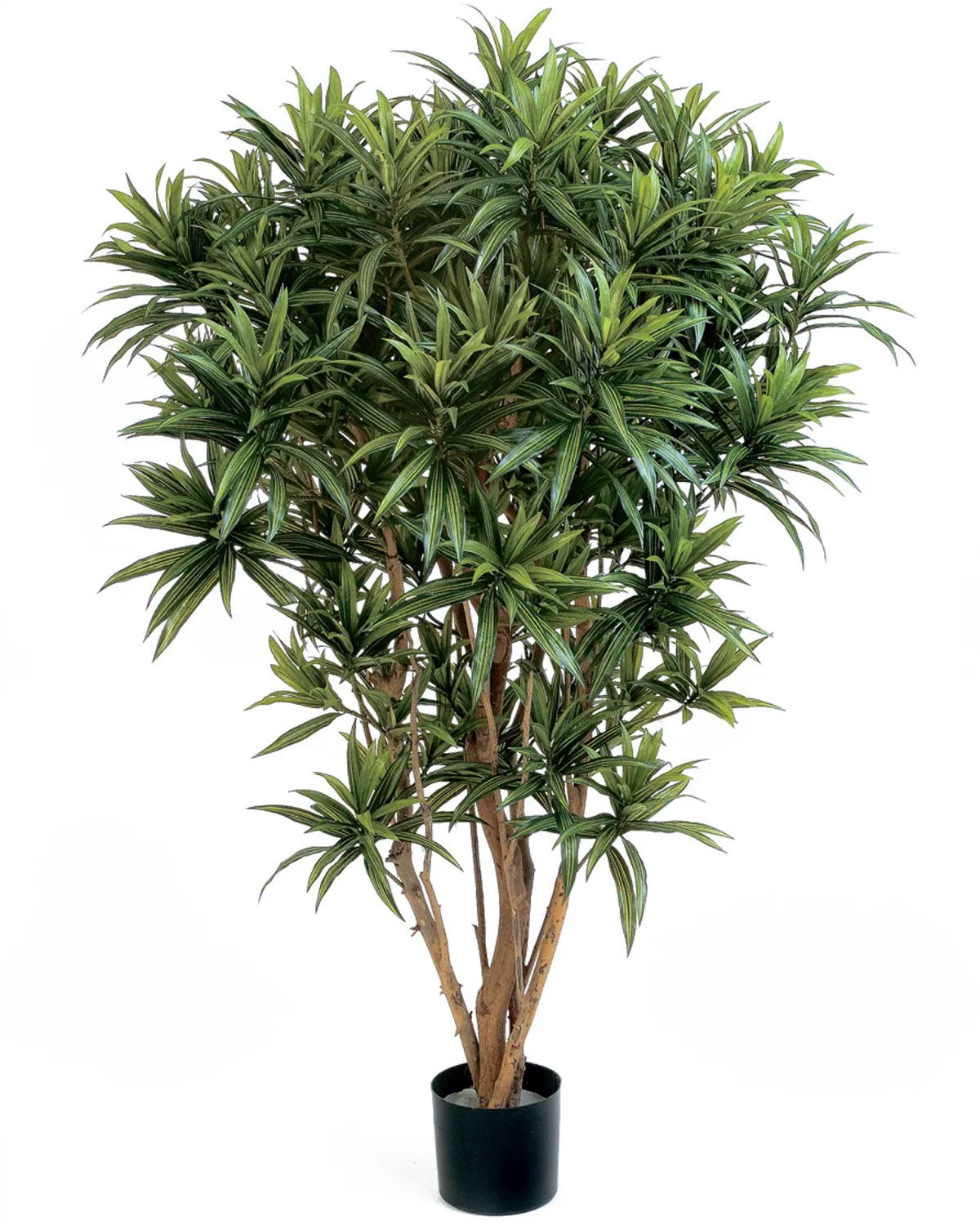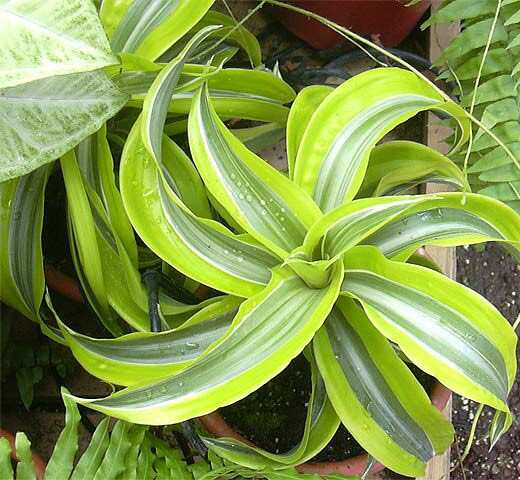When you know what to plant next to this or...
My Beautiful Dracaena Reflexa [Song of India]
The bare trunk and leaves in bunches growing only at the ends of the shoot make it possible to identify Dracaena Reflexa, like all other dracaena types, to false palms. However, this plant has some differences from the most of dracaena varieties:its branches extend from the very base of the trunk. This feature makes the tree look like a branchy shrub rather than a palm tree. The interesting name of Dracaena Reflexa was formed due to its external feature - leaves curved in the shape of an arc.
✔ We Released The Dracaena HandBook
CLICK HERE TO LEARN MORE >>
This type of dracaena has green lanceolate leaves with a light border. Each dense leaf begins with a wide base with which it adheres firmly to the stem. The length of the leaves ranges from 11 to 16 cm.
Dracaena Reflexa is characterized by short, thick, pointed leaves. Depending on the species, the leaves of Dracaena Reflexa are dark green to light green with beige or pale yellow stripes. Dracaena Reflexa “Song of India” boasts bright yellow, variegated leaf stripes.

This dracaena grows rather slowly in an upright position with an open crown. Lanceolate leaves 5-20 cm long and 1.5-5 cm wide are arranged in a spiral, from the base of the plant, with parallel venation along the entire length.
Flowers of Dracaena Reflexa are small and usually white, clustered in inflorescences, they appear in mid-winter. Dracaena blooms very rarely. Neither flowers nor fruits are distinguished by a particularly spectacular appearance.
Dracaena Reflexa - Plant Care Guide

Growing and care:
- Dracaena Reflexa is grown indoors as an ornamental leafy plant, where the air is not too dry and there is enough warmth;
- In mild climates, it is planted outdoors;
- In cold climates, it can be exposed to the air during the warmer months, but the plant must be brought indoors in the beginning of the autumn. When grown in a pot, use a mixture of peat (3/4) and sand (1/4) or fertile soil, sand and peat, taken in equal parts. During the growing season, Dracaena Reflexa is fed with long-acting fertilizers containing trace elements.
Location:
- In winter, the place for Dracaena Reflexa should be well lit, while in summer, in addition to good lighting, it is necessary to exclude direct sunlight;
- Do not place the plant in direct sunlight to avoid leaf burns;
- The brighter and more variegated the color of the leaf blades, the more light is needed to preserve the decorativeness of the specimen.

Temperature:
- In winter - not lower than 16-18 ° С
- In summer - no higher than 23 ° С
Watering:
- Keep the soil moist all the time (but without stagnant water), never overdry it;
- For watering Dracaena Reflexa use soft water of room temperature;
- In summer, the plant needs abundant watering, but do not forget to reduce watering in winter;
- Maintain air humidity at the level of 70% - 75%, at least at the level of 50%;
- In summer heat and when the heating devices are on, additionally spray Dracena Reflexa.
Repotting:
- In order not to damage the roots, it is better to replace the repotting of Dracaena Reflexa with changing the top layer of the soil;
- Repot the plant in spring or summer every 2-3 years;
- Choose a larger pot than the previous one, fill it with the same kind of soil;
- Use ready-made soil for dracaena or prepare the soil by yourself, for this take turf soil, humus and sand in equal parts;
- In mature plants, replace the top 10-15 cm of soil annually instead of repotting.
Maintaining the appearance of the plant:
- Regularly clean the leaves from dust and dirt with a damp soft cloth;
- Prune loose and damaged leaves and branches.
Poisonous
Remember that Dracaena Reflexa is toxic to both cats and dogs. Do not allow your pets chew the leaves of the plant. It can cause weakness, vomiting and indigestion. At the first signs of poisoning, immediately bring your pet to a veterinarian. See more about pets and the effect toxins have here at the ASPCA.
How to propagate Dracaena Reflexa

- To propagate Dracaena Reflexa, root the apical cuttings and stem cuttings at a temperature not lower than 25°C and high humidity;
- For best results, use a rooting stimulant;
- At the same temperature you can sow the seeds, lightly sprinkling them with soil on top;
- Cover the container with seeds with foil or glass before germination, and do not forget to ventilate the greenhouse daily in the morning and in the evening.
Diseases and pests of Dracaena Reflexa

- Dracaena Reflexa is very sensitive to the use of luster solutions, which give gloss to the leaves;
- Dracaena Reflexa is an unpretentious plant, but it can become infected with late blight, anthracnose, bacterial leaf spot, root rot, powdery mildew;
- This type of dracaena is affected by worms and aphids;
- To get rid of insects, first remove adult ones with a cloth or cotton swab dipped in alcohol, then treat the plant with an insecticide;
- If necessary - repeat the treatment after 7-10 days;
- Remember to take precautions when working with insecticides due to the toxicity of the preparations.
Diseases occur to Dracaena Reflexa mainly due to violations of the conditions of detention.
For instance:
- With overdrying or waterlogging the soil, leaves may turn yellow and fall off;
- When the air is too dry, the tips of the leaves dry up and the leaves start to curl;
- When spraying or watering with hard water, brown spots appear on the leaves.
Dracaena Reflexa is a rather unpretentious plant that will decorate your home and will delight you throughout the year.
Dracaena Reflexa - Song of India Plant
The most popular species of Dracaena Reflexa is Song of India plant.
Reflexa Song of India in the wild grows in the tropical forests of Asia, America and Africa. As an indoor plant, this is an evergreen shrub with a bare woody stem reaching a height of about 3 meters. The main advantage of Song of India plant is the leaves with a bright color: they have a central, longitudinal green stripe bordered on both sides by stripes of the color of ripe corn.
Reflexa Song of India Care Tips:
Proper care for Reflexa Song of India involves organizing regular watering, good lighting and optimal humidity.
-
Song of India prefers high temperature and humidity, which recreate the conditions in its homeland: air with temperatures from +16°C to +28°C degrees and humidity over 70%. It is recommended to spray Song of India leaves daily with warm and soft water.
-
Organize for your Song of India bright lighting. When placed on a south-facing window, the plant should be protected from the direct sunlight.
-
Water Song of India 3-4 times a week, avoiding overflow or overdrying.
-
The frequency of feeding Song of India depends on the season: in summer and spring, during the period of active growth, fertilize the plant once a week, in winter reduce it to 1 time per month.
-
Remember that Song of India plants are toxic to cats. So make sure your favorite pet does not chew the leaves of the plant. It’s better to place Song of India plant where your cat can’t reach it. If you notice signs of poisoning, weakness or vomiting in your cat, contact your veterinarian immediately.
About the Author
My name is Michael Bauer,
I have been growing and taking care of plants for 20 years. My dream has become a reality. I've had many difficulties along the way, but my love for our favorite plants has really helped me.
















